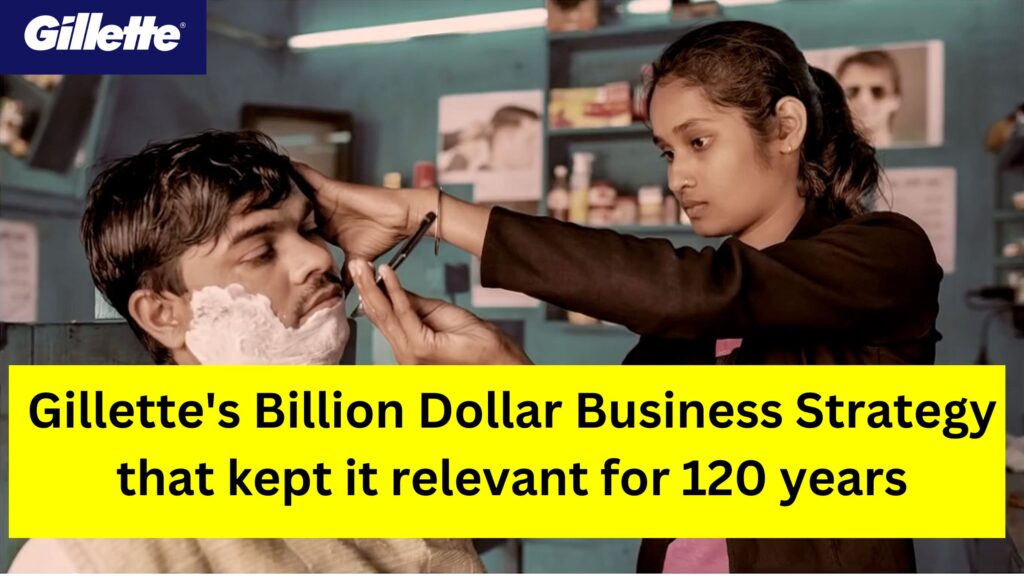Gillette is one of the most revolutionary companies of the 20th century. It is one of those very few companies that have survived for more than 120 years which includes more than 7 revolutions and 2 World Wars.
What is more fascinating about Gillette is not the growth of the company, but the fact that Gillette gave the world a billion-dollar idea. This idea laid the foundations of success for some of the biggest ventures on the planet which include PlayStation, Xbox, Kodak, and even Amazon Kindle.
The question is What exactly is this strategy?
- How did a razor company go on to inspire legendary products like PlayStation and Xbox?
- How can you apply this strategy to your startups?
Story of Gillette
The answer to this question lies in the history of the Gillette company which dates back to the late 1800s. This was the time wherein the trend of dense beards was fading away and the trend of clean shave mustache look was on the rise. But back then shaving was not an easy task it was even considered to be a dangerous undertaking In the late 1800s if you wanted to shave you had only 2 options.

1. Straight Razor
The straight razor is the one that looked very similar to the ones you might have seen in Game of Thrones. They were considered to be very risky because they were super sharp and people were kinda scared to get them too close to their face or their neck.
2. Safety Razor
On the other hand, the safety razor was a one-time purchase. But once you bought it you had to frequently keep sharpening it. That was a very very tedious procedure.
The men of the 19th century had to seek professional help and they visited the barber shop 2-3 times every single week.
The idea of the Razor Blade Model

One fine day, a traveling salesman was getting late for work. He got extremely fed up with using his life-threatening razor. He had completely lost his patience to keep sharpening the safety blade every time he wanted to shave. That’s when he thought, why not have a razor with a detachable, disposable blade that can just be thrown away after every shave and can be replaced by a new one? And that is how the ideation of the modern-day razor blade happened. This angry, pissed-off salesman was none other than Mr. King Gillete himself. His vision gave birth to the revolutionary invention of disposable blades which then went on to change men’s grooming forever.
King Gillette collaborated with his friend and got a patent for their razors and their blades, which is why nobody in the market could mimic their iconic design. That is how for the next 15 years Gillette remained a market leader and became a million-dollar company.
Things started to change in 1921 and this is when the patents of the Gillette razor blade expired. Within just one year every single Gillette competitor was making a similar pair of razor blades. This put Gillette into deep-deep trouble.
This was clearly reflected in their sales numbers also From 1921 onwards, the sales of Gillette razors saw a massive decline of 20% in just one year, which is like a crazy downfall for a company that had been a market leader for more than a decade. Now, here’s where they really needed to do something magical to save the company from failing. That is when they came out with a pricing model called the Razor Blade model.
Razor Blade Model of Business

This model went on to change the very dynamics of the razor business forever. This model was based on a very simple philosophy. Wherein they said, ‘Let’s sell the razors at an ultra-cheap price with low margins and then sell blades at a higher margin. So that, when the customer keeps buying the blades. We can have a recurring profit from each customer.
Basically, in one line it meant, “Give them the razors and make them come back for blades”. So Gillette started selling razors at an ultra-cheap rate to compete with the competition. Sometimes they even sold it at a loss, just so that they can get people into the “Gillette Ecosystem”. And guess what?
Within a year the sales of Gillette razors shot up and after 1922 when the razor blade strategy was fully implemented, the sales of Gillette razors skyrocketed by a humongous 127%. I repeat, Gillette went from seeing a 20% decline in its sales to seeing a massive increase of 127% in just one year, because of the execution of the Razor Blade strategy. That is how Gillette established a legacy in pricing and today, even after 100 years, it still serves as an inspiration for some of the most iconic brands of the 21st century.
The Razor Blade model, even today, is taught extensively in Business schools all around the world.
How Sony use the Razor Blade model in their Business
Today Sony uses its pricing model and sells its PlayStation consoles at a loss, just so that it can make recurring profits through CDs and PlayStation Plus subscriptions. In fact, Sony incurred a loss of about 60$ which is about ₹4200 for every PS4 console they sold, just so that they could make billions through CDs and subscriptions.
How Kodak uses Razor Blade Model in their Business
Kodak sold cameras at a dearth cheap cost just to make customers come back for the film rolls.
How Amazon Kindle uses Razor Blade Model in their Business
Amazon Kindle today, is being sold at almost 0 profit just so that Amazon can make billions out of its e-book sales. This is the power of the Razor Blade model.
My Favourite Marketing Ad from Gillette
#ShavingStereotypes by Gillette. This Campaign is inspired by the true story of two girls from Banwari Tola. (India). These two girls are shaving the stereotype of society by doing the job reserved for men. The story is told by Gillette through aAd. Wherein the story was told by an 8 years old boy who is thinking that society has been biased some profession is for boys only and some profession is for girls only. His thought changes when he reaches a barber shop and sees girls doing the job.
How can you apply this model to your Startup or Business?
1. Ecosystem results in a massive customer retention
The thing that you need to understand is that getting your customers into your ecosystem will always give you an unfair advantage over your competition because an ecosystem always results in massive customer retention.
2. Minimize the Reluctancy point
While you apply this model you need to find the points of maximum reluctance and then you have to work on minimizing it For example, you would be more reluctant to buy a PS4 console as compared to buying PS4 the games after buying the console. Therefore, selling consoles at a loss and hiking the price of the games will give you exponential returns as compared to doing it otherwise.
3. Don’t be Dependent on Razor Blade Model
You need to be careful to not be so dependent on this model that you end up neglecting the very possibility of disruption because this is exactly what happened with Kodak.
Kodak Bankrupt due to dependency on Razor blade model
I don’t know how many of you actually know this but then Kodak was so stuck on making money by selling their film rolls, that inspite of being one of the first companies to file a patent for digital cameras, they did not realize that the film roll itself will seize to exist with the rise of the digital revolution. And the fact that by sticking to the razor blade model, they were practically digging their own grave.
4. Pricing is a double-edged sword
Every entrepreneur needs to realize that pricing is a double-edged sword. When used right, it will give you incredible returns but if you don’t keep the track of the changes, it can even kill your business.
That’s all from my side for today, if you learned something valuable, please make sure to write your feedback in the comment box.
Do you Know How Asian Paints Built MONOPOLY in the Indian market?





Pingback: Burger King BUSINESS STRATEGY to compete with McDonald - SachinThakur.in